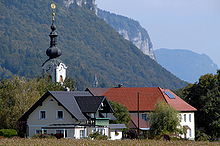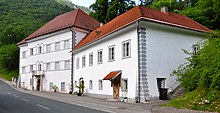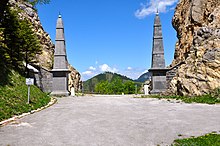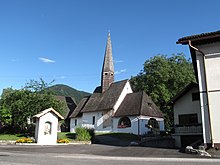Ferlach
|
Borough Ferlach
|
||
|---|---|---|
| coat of arms | Austria map | |
|
|
||
| Basic data | ||
| Country: | Austria | |
| State : | Carinthia | |
| Political District : | Klagenfurt-Land | |
| License plate : | KL | |
| Surface: | 117.31 km² | |
| Coordinates : | 46 ° 32 ' N , 14 ° 18' E | |
| Height : | 466 m above sea level A. | |
| Residents : | 7.123 (January 1, 2020) | |
| Postal code : | 9170 | |
| Area code : | 04227 | |
| Community code : | 2 04 05 | |
| NUTS region | AT211 | |
| Address of the municipal administration: |
Kirchgasse 5 9170 Ferlach |
|
| Website: | ||
| politics | ||
| Mayor : | Ingo Appé ( SPÖ ) | |
|
Municipal Council : ( 2015 ) (27 members) |
||
| Location of Ferlach in the Klagenfurt-Land district | ||
| Source: Municipal data from Statistics Austria | ||
Ferlach ( Slovenian : Borovlje ) in Carinthia is the southernmost municipality in Austria with 7123 inhabitants (as of January 1, 2020), the capital of the Rose Valley , seat of a district court and known as a gunsmith town.
geography
Ferlach is located south of Klagenfurt (10 km as the crow flies, 18 km by road) in the center of the Rosental on the Drau , which is dammed up here to form the Ferlach reservoir . North of Ferlach is the Sattnitzgebirge , to the south the Karawanken rise with the "local mountain" Ferlacher Horn ( 1840 m ) and the Singerberg ( 1589 m ), between which the Loiblbach flows towards the city.
The highest point in the municipality is the Vertatscha summit ( 2181 m ), the lowest is near the village of Laak (411 m).
climate
|
Average monthly temperatures and precipitation for Ferlach
|
||||||||||||||||||||||||||||||||||||||||||||||||||||||||||||||||||||||||||||||||||||||||||||||||||||||||||||||||||||||||||||||||||||||||||||||||||||||
Community structure
Ferlach is divided into nine cadastral communities (the Slovenian names in brackets): Ferlach ( Borovlje ), Kappel an der Drau ( Kapla ob Dravi ), Kirschentheuer ( Kožentavra ), Unterloibl ( Podljubelj ), Waidisch ( Bajdiše ), Unterferlach ( Medborovachlain ) ( Glinje ), Seidolach ( Ždovlje ) and Windisch Bleiberg ( Slovenji Plajberg ).
The municipality includes the following 27 localities (population as of January 1, 2020):
- Babniak ( Babnjak ) (25)
- Bodental ( Poden ) (140)
- Dörfl ( Kajže ) (18)
- Dornach ( Trnje ) (102)
- Ferlach ( Borovlje ) (4316)
- Glainach ( Glinje ) (76)
- Görtschach ( Goriče ) (254)
- Jaklin ( Jaklin ) (4)
- Kappel an der Drau ( Kapla ob Dravi ) (308)
- Cherry Teaser ( Kožentavra ) (221)
- Laak ( Loka ) (45)
- Laiplach ( Liplje ) (14)
- Loibltal ( Brodi ) (40)
- Otrouza ( Otrovca ) (69)
- Rauth ( tail ) (5)
- Reßnig ( Resnik ) (202)
- Seidolach ( Ždovlje ) (65)
- Singerberg ( Žingarica ) (5)
- Bouquet ( Struga ) (259)
- Strugarjach ( Strugarje ) (6)
- Drafts ( Trata ) (63)
- Unterbergen ( Podgora ) (155)
- Unterferlach ( Medborovnica ) (312)
- Unterglainach ( Vesca ) (32)
- Unterloibl ( Podljubelj ) (219)
- Waidisch ( Bajdiše ) (75) including Unter Waidisch
- Windisch Bleiberg ( Slovenji Plajberk ) (93)
Other locations are the Rotte Waidisch and the scattered settlement Plajberg .
Neighboring communities
| Köttmannsdorf | Maria Rain | Ebenthal in Carinthia |
| Feistritz in the Rosental |

|
Sankt Margareten im Rosental |
| Žirovnica , Tržič | Cell |
history
The place Ferlach should have originated in the 12th century. The oldest written mention as Vörelach comes from the year 1246. The place name alludes to the surrounding pine forests (Slov. Borovlje : people at the pine forest ).
An iron processing industry has been demonstrable for Ferlach since the 14th century and was favored by the ore deposits in the Karawanken and the water power of the Loibl and Waidischerbach. The development as a production facility for weapons probably goes back to the elevation of Klagenfurt to the state capital around 1529. Against the background of Turkish invasions and peasant uprisings, Klagenfurt, which was almost completely burned down and rebuilt in 1514, received a municipal armory from Emperor Ferdinand I , which had to be equipped accordingly. According to legend, Ferdinand is said to have brought hundreds of armory smiths from Liège, then in the Austrian Netherlands , to Carinthia in 1558 . However, so far not a single Flemish or Walloon name has been identified in the lists of gunsmiths. According to an instruction from Ferdinand in 1558, halberds , pikes and firearms were already being produced in large quantities at that time. The emperor instructed the Ljubljana kitman Hans Tillhopff to order 400 “Topplhackhn und sovil spanische Ror” from “Hansen Pixenschmidt zu Hollenburg” in Carinthia. The earliest mentions of gunsmiths so far can be found in the records of the Hollenburg estate. In 1551 the "puechsenschiffter" Hans Glawitsch is mentioned, in 1555 the locksmith Hans Hueber and in 1557 the "puchsenschmidt" Hans Butsch. In 1641 around 41 masters were active in the Ferlach area. The gunsmithing trade reached its peak during the reign of Empress Maria Theresa and achieved world fame. Up to 400 masters can be found in the Hollenburg land records . In addition to the Austrian army, the gunsmiths also equipped the armies of France , Spain and Turkey . In the decades that followed, the demand for military weapons decreased, and so Ferlach concentrated on the production of hunting weapons . The Ferlach hunting rifles, which are entirely handmade, still enjoy an excellent reputation today.
The community was constituted in 1850 under the name Oberferlach. In 1880 the village had 888 inhabitants. Of these, 561 were German (63%) and 313 Slovenian (35%). Oberferlach was a language island with a predominantly Slovenian surrounding area. On the occasion of the elevation to the market in 1910, the community was renamed Ferlach. In 1930 town charter was granted. The municipality of Unterloibl was incorporated in 1927, Unterferlach in 1964 and Windisch Bleiberg in 1973.
The Ferlach gunsmith Ivan Dovjak, born in 1905, was one of the 13 resistance fighters against National Socialism in Carinthia, sentenced to death on April 9, 1943 by Roland Freisler, President of the People's Court (VGH), and sentenced to death on April 29, 1943 in the Vienna Regional Court (prison ) were executed.
The Loibl concentration camp was established in March 1943 in the Loibltal on both sides of the Loibl Pass as a branch of the Mauthausen concentration camp . By the end of the war, around 1,800 prisoners and around 400 civilians had to dig a tunnel through the Karawanken under the border between Slovenia and Austria . 32 inmates were beaten to death or deliberately murdered.
After the capitulation date on May 8, fierce fighting broke out in and near Ferlach between May 10 and 13 between partisans on the one hand and the Slovenian National Army and SS units on the other. Numerous buildings in Ferlach were set on fire. The number of dead Slovenian armed forces men is given between 3 and 50. The number of dead partisans varies between 18 and 180. They were buried in the former Ferlach cemetery - now Gregoritschpark. The men of the Waffen SS and SS police who fought against the Slovenian Landwehr did not suffer any losses.
Between May 8 and May 24, there were several massacres in the Ferlach area. The most famous massacre took place on May 13, 1945 in the Reichmannwald in Otrouza. There 16 Slovenian refugees including 3 women were murdered by partisans, they are buried in the mass grave complex at the parish cemetery of Glainach.
In 1997 the Carinthian provincial exhibition "All hunting ... a cultural history" took place in Ferlach .
population
According to Statistics Austria as of December 31, 2011, the municipality of Ferlach has 7,272 inhabitants. 8% of them belong to the Carinthian Slovenes .
81% of the community population profess to the Roman Catholic Church , 3.5% to the Evangelical Church and 4.0% to Islam . 9.5% describe themselves as non-denominational.
Population development

Culture and sights
In 2010, the traditional gunsmithing trade as Ferlach gunsmiths was declared an intangible world heritage , as declared by UNESCO, in the national register of intangible cultural heritage in Austria .
Museums
- Gunsmith and Hunting Museum in Ferlach Castle
- Carnica bee museum in Kirschentheuer
- Historama , Museum of Technology and Transport
- Museum of the Carinthian Iron and Steel Works (KESTAG) as part of the Historama
Buildings
- Ferlach Castle
- City parish church of St. Martin
- Parish church Kappel an der Drau
- District Court Ferlach
Object on the subject of "Carinthian referendum 1920" in Reßnig
The idea of a memorial to commemorate the Carinthian referendum came from the artist Rolf Gutenberger. The technical implementation was carried out by the blacksmith Markus Pirker with the help of the HTBL Ferlach. Symbolic representation of the nine federal states of Austria based on the shape of the magic cube . The southernmost federal state of Carinthia threatens to tip out of the formation and is pushed back into its original position by the two figures. These two figures symbolize the German and Windy Carinthians who fought together for their homeland and with the green ballot papers contributed to Carinthia remaining with Austria. The breakthrough on the heart side stands for the voting slip (“bearing the spirit in the heart”), the gravel bed as a symbol for the Drava . The stone on which the project rests is Krastal marble .
nature
- Tscheppaschlucht
- Drau reservoir near Glainach with summer ferry service
- Bathing lake in Reßnig
- Bodental
A largely unpaved road leads from Windisch Bleiberg into Bärental and reaches its culmination point at the so-called Krischnig- Sattel in the Strugarjach district at 1086 m above sea level. The Krischnig-Sattel is located between two foothills of the Karawanken , in the north the Sinacher Gupf ( 1577 m ) and in the south the less known foothills of the Kosiak ( 2024 m ), the Große Rain ( 1464 m ). Up to there it is publicly accessible, the road marked as private and leading into Bärental is cordoned off with a barrier in the area of the Stornig homestead and a driving ban is signposted. However, hiking is always possible. Nature lovers from the immediate and wider area use the Sinacher Gupf as an excursion destination, from the summit of which there is a view of the Rosental valley to the north and the Sattnitz mountain range . Another highlight is the hike to the end of the Bodental with the “fairy tale meadow” under the mighty rock faces of the Vertatscha; In winter, the cross-country ski trail ends here, which begins at Gasthaus Sereinig and climbs around 150 meters.
Economy and Infrastructure
traffic
The Loiblpass Straße (B 91) as a connecting road from Klagenfurt to Tržič (Neumarktl) and the Rosental Straße (B 85) lead through the municipality of Ferlach .
The Rosentalbahn runs via Maria Rain to Weizelsdorf, from where the Ferlach-Weizelsdorf local railway branches off, and on to Rosenbach, where it meets the Karawankenbahn .
Ferlach is a hub for public transport. In Ferlach, bus routes from PostBus AG of ÖBB and the private bus company Juwan come together. In addition, the Weizelsdorf train station in Ferlach is served by the S3 S-Bahn line. The direct bus service (Monday to Friday) from Klagenfurt to Ferlach was largely discontinued in the course of this changeover; only a few courses in the morning and in the evening are still served by buses. On weekends and public holidays, only the bus runs from Klagenfurt to Ferlach.
- PostBus AG (an ÖBB company )
- Ferlach ↔ Klagenfurt (some courses, as well as Saturday, Sunday and public holidays)
- Ferlach ↔ Rosenbach (Carinthia)
- Ferlach ↔ Unterloibl ↔ Klagenfurt
- Ferlach ↔ Feistritz im Rosental
- Juwan Kärntenbus
- Ferlach ↔ Abbey
- Ferlach ↔ Zell (Sele)
- Ferlach ↔ Bodental ( Poden )
Furthermore, in summer a line is led to the Tscheppaschlucht and back.
Until the mid-1950s, Ferlach was still served by train by the ÖBB. The railway line of the so-called Ferlacher Bahn belongs to the municipality and the NBiK today . A direct connection from Ferlach by train has been discussed again and again since then.
education
- Ferlach vocational school
- HTBLuVA Ferlach
- Ferlach secondary school
- Primary schools (VS 1, VS 2 South, VS 3)
Craft
For 500 years, Ferlach has been a center of craft hunting weapons production. One focus of the gunsmith's work is high-quality sockets .
politics
City Councilor and Mayor
The city council (city government) consists of 7 members:
- Mayor Ingo Appé (SPÖ)
- 1st Vice Mayor Christian Gamsler (SPÖ)
- 2nd Vice Mayor Astrid Kirschner-Mack (SPÖ)
- City Councilor Franz Wutte (SPÖ)
- City Councilor Ervin Hukarevic (SPÖ)
- City Councilor Sven Skjellet (ÖVP)
- City Councilor Franz Wutti (VS / WG)
Municipal council
The municipal council of Ferlach has 27 members and has been composed as follows since the municipal council election in 2015 :
- 15 SPÖ
- 5 ÖVP
- 3 Volilna Skupnost - electoral community
- 2 FPÖ
- 2 greens
coat of arms
The central motif of the Ferlach coat of arms is the pine , the tree and the cones that characterize it stand for the name of the place or the municipality. The crossed nails allude to the nail smiths that have been operating in Ferlach since the early modern era, and the rifle and the target on the Ferlach weapon manufacture, which has shaped Ferlach since the 16th century.
The coat of arms was first awarded to the municipality on August 27, 1960, a new award took place on June 20, 1973. The official blazon of the coat of arms reads:
- "Red semicircular shield with a black-stemmed green pine tree, top right by two silver crossed nails, top left by a silver pine cone pointing downwards and lower left by a silver rifle, from the barrel of which a silver and black contoured red target is overlaid."
The flag is red-green with an incorporated coat of arms.
sport and freetime
The most famous sports club is SC Ferlach , whose handball section played in the top Austrian league, the HLA , in the 2013/14 season .
Personalities
- Hans Schmidt von und zu Helding (1600–1669), ancestor of the Ferlach gunsmiths
- Ignatz Jakob Hubmershofen von Silbernagl (* 1755), trade owner in Ferlach and Waidisch, founder of the churches in Dollich and Waidisch, defender of the Loibl Pass against the French
- Jakob II. Peregin Paulitsch (born April 27, 1757), first non-aristocratic Prince-Bishop of Gurk
- Anton Gregoritsch (1868–1923), officer, painter, war draftsman
- Stefan Singer (born December 22, 1871), former dean, dean of honor in Kappel an der Drau, historian (history of several South Carinthian deaneries, 1934 and 1935) imprisoned in the Dachau concentration camp in the bunker
- Hermann Poschinger (1886–1965), teacher and academic painter
- Josef Friedrich Perkonig (1890–1959), storyteller, playwright, author of radio and television plays, film producer, teacher and honorary citizen of the city of Ferlach
- Ivan / Johann Doujak (1905–1943), resistance fighter against National Socialism, executed on April 29, 1943 in Vienna
- Peter Tschauko (born February 6, 1906), doctor, world traveler, naturalist and collector
- Johannes Csiesciutti (born December 7, 1906), poet "Baraberdichter", honorary citizen of the city of Ferlach
- Anton Woschitz (1925–2004), school director, mayor and member of the Austrian National Council
- Odo J. Struger (1931–1998), pioneer in industrial electronics, played a key role in the development of the first programmable logic controller (PLC)
- Alfred Ogris (* February 1941), Univ. Lecturer, eminent historian, former regional archives director of Carinthia
- Helmut Schmid (1942–2018), one of the most important typographers of the 20th century
- Thomas Partl (* ≈1947), head of the Ferlach District Court and President of the Carinthian Football Association
- Wolfgang Petritsch (* 1947), diplomat, writer, since March 4, 2008 Ambassador of the Republic of Austria to the OECD in Paris, former High Representative for Bosnia and Herzegovina , honorary citizen of the city of Ferlach
- Edgar Geramb (* 1895–1967) city pastor from 1932 to 1967, outstanding youth educator and their role model
literature
- Rainer Adamik: Ferlacher Chronik. A historical overview of the events in the municipality. Published by Kulturring Ferlach, self-published, 2009, 80 pages.
- Stephan Singer: Culture and church history of the lower rose valley. Deanery Ferlach. Kappel 1934. Self-published by the author.
- Hans M. Tuschar: Ferlach. History and stories. Verlag Johannes Heyn, Klagenfurt 1996, 512 pages, ISBN 3-85366-816-X .
- Dekanalamt Ferlach (ed.) / Dekanijski urad Borovlje (izd.): Deanery Ferlach, past and present = Dekanija Borovlje, zgodovina in sedanjost . Klagenfurt / Celovec [ea] 2012.
- Hans M. Tuschar: Familiar one-shift . (Windisch Bleiberg, Bodental, Loibltal). Ferlach, self-published 2019, 464 pages, ISBN 978-3-9504627-3-9
Web links
- City of Ferlach
- 20405 - Ferlach. Community data, Statistics Austria .
Individual evidence
- ↑ Statistics Austria: Population on January 1st, 2020 by locality (area status on January 1st, 2020) , ( CSV )
- ↑ Heinz-Dieter Pohl : List of places with a brief etymology. October 29, 2013, archived from the original on October 29, 2013 ; accessed on July 11, 2020 .
- ↑ Stephan Singer: Culture and Church History of the Lower Rosental , p. 166.
- ↑ Hans M. Tuschar: Ferlach. History and Stories , p. 111.
- ↑ KK Statistische Central-Commission, Special-Orts-Repertorien of the kingdoms and countries represented in the Oesterreichischen Reichsrathe. Volume V: Carinthia (Vienna 1883), p. 16.
- ^ A b Christian Wehrschütz: New findings on partisan violence. In: orf.at. June 11, 2011, accessed July 11, 2020 .
- ^ Christian Wehrschütz: Partisan violence in Carinthia after 1945. In: wehrschuetz.at. June 10, 2011, accessed July 11, 2020 .
- ↑ Florian T. Rulitz: The tragedy of Bleiburg and Viktring. Partisan violence in Carinthia using the example of the anti-communist refugees in May 1945 . Hermagoras Verlag , Klagenfurt / Ljubljana / Vienna 2011. ISBN 978-3-7086-0616-3 , p. 235.
- ↑ Florian T. Rulitz: The tragedy of Bleiburg and Viktring. Partisan violence in Carinthia using the example of the anti-communist refugees in May 1945 . Hermagoras Verlag , Klagenfurt / Ljubljana / Vienna 2011. ISBN 978-3-7086-0616-3 , p. 219.
- ↑ Ferlach gunsmiths. Traditional handicrafts in Carinthia, recorded 2010. In: Austrian Commission for UNESCO . Retrieved July 11, 2020 .
- ↑ Ferlacher Büchsenmacherei ( Memento from January 9, 2015 in the Internet Archive )
- ^ Quoted from Wilhelm Deuer: The Carinthian municipal coat of arms . Verlag des Kärntner Landesarchiv, Klagenfurt 2006, ISBN 3-900531-64-1 , p. 92






















